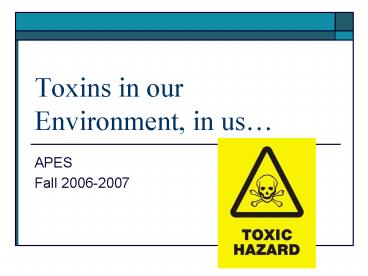Toxins in our Environment, in us - PowerPoint PPT Presentation
1 / 35
Title:
Toxins in our Environment, in us
Description:
How do we minimize the toxic effects? How do we measure toxicity? ... Cells reproduce quickly to slough off and protect themselves this way. ... – PowerPoint PPT presentation
Number of Views:73
Avg rating:3.0/5.0
Title: Toxins in our Environment, in us
1
Toxins in our Environment, in us
- APES
- Fall 2006-2007
2
- Why should you
- care
- about Toxins?
3
(No Transcript)
4
(No Transcript)
5
(No Transcript)
6
We will address these topics today
- Movement, distribution, and fate of toxins
- How do we minimize the toxic effects?
- How do we measure toxicity?
7
We need to consider this from three levels, or
factors
- Factors relating to the toxin itself
- Factors related to exposure to the toxin
- Factors relating to the organism
8
The Toxic Agent
- Whats its composition?
- Its reactivity with the environs?
- Its solubility and state of matter (S,L,G, P)
- Presence of impurities/contaminants
- Availability of a vehicle to carry it
- Movement of agent thru body tissues/cells
9
Factors Related to Exposure
- Dose received by victim
- Route, rate and site of exposure
- Duration of exposure
- Frequency of exposure
- Time of exposure (day, season,year)
10
Factors Related to the Organism
- Resistance to uptake, storage, cell permeability
- Ability to metabolize, inactivate, sequester, or
eliminate agent - Tendency to activate other substances to toxicity
- Concurrent health issues/stresses
- Species and genetic characteristics
- Nutritional status of subject
- Age, sex, wt, immune system status, maturity
11
Factors to consider when dealing with Toxins
- Solubility
- Bioaccumulation
- Biomagnification
- Persistence
- Chemical interactions
12
Solubility
- As water solubility of the toxin goes up, danger
goes up! It moves around faster - In the body
- And in our
- World.
13
Solubility
- Oil-Fat soluble toxins
- Are harder to move around
- And then once in the body
- Accumulate in the fat.
- They can just hang out
- There and do damage for a
- Long time..slowly leaking into the body.
14
(No Transcript)
15
Bioaccumulation and Biomagnification
- Bioaccumulation
- Absorption and storage of molecules.
- Biomagnification
- The accumulation of toxins low in the tropic
levels works its way up the food chain.
16
(No Transcript)
17
(No Transcript)
18
Persistence
- Some toxins degrade rapidly, others hold their
chemical structure. - Some things are engineered to hold
structurethats what we value! Its bad tho if
they are dangerousand get out in the
water..imagine.
19
(No Transcript)
20
(No Transcript)
21
Chemical Interactions
- Antagonistic reactions
- Interference with effects of or break down other
chemicals (antioxidants) - Additive effects
- Effects get emphasized (lead and arsenic)
- Synergistic effects
- One substance exacerbates the effects of another
(asbestos and smoking)
22
(No Transcript)
23
(No Transcript)
24
- Research on lead and arsenic
- Asbestos study
25
How can we minimize the effects?
- Metabolic degradation and excretion
- Repair mechanisms
26
Your liver, your filter for toxins
27
(No Transcript)
28
(No Transcript)
29
(No Transcript)
30
Protection built in to your body!
- Cells reproduce quickly to slough off and protect
themselves this way. - Irritants (smoking and drinking) reduce the
bodys ability to do this effectively. - We were not meant to live as long as we do thats
why we dont have a resistance to cancer.
31
How do we measure toxicity?
- Can you eat too many bananas?
- Isnt it the perfect food?
32
Paracelsus-German scientist
- The dose makes the poison
33
Animal Testing
34
More human methods include
- Computer simulations
- Cell cultures
- We still use animal testing despite the options.
- WHY?
- Our policies are based on these tests. So
politics runs this show.
35
(No Transcript)































